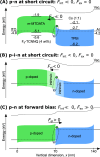Tuning Charge-Transfer States by Interface Electric Fields
- PMID: 38841759
- PMCID: PMC11194774
- DOI: 10.1021/acsami.4c04602
Tuning Charge-Transfer States by Interface Electric Fields
Abstract
Intermolecular charge-transfer (CT) states are extended excitons with a charge separation on the nanometer scale. Through absorption and emission processes, they couple to the ground state. This property is employed both in light-emitting and light-absorbing devices. Their conception often relies on donor-acceptor (D-A) interfaces, so-called type-II heterojunctions, which usually generate significant electric fields. Several recent studies claim that these fields alter the energetic configuration of the CT states at the interface, an idea holding prospects like multicolor emission from a single emissive interface or shifting the absorption characteristics of a photodetector. Here, we test this hypothesis and contribute to the discussion by presenting a new model system. Through the fabrication of planar organic p-(i-)n junctions, we generate an ensemble of oriented CT states that allows the systematic assessment of electric field impacts. By increasing the thickness of the intrinsic layer at the D-A interface from 0 to 20 nm and by applying external voltages up to 6 V, we realize two different scenarios that controllably tune the intrinsic and extrinsic electric interface fields. By this, we obtain significant shifts of the CT-state peak emission of about 0.5 eV (170 nm from red to green color) from the same D-A material combination. This effect can be explained in a classical electrostatic picture, as the interface electric field alters the potential energy of the electric CT-state dipole. This study illustrates that CT-state energies can be tuned significantly if their electric dipoles are aligned to the interface electric field.
Keywords: charge-transfer states; color tuning; exciplex emission; interface electric fields; organic p–n junction.
Conflict of interest statement
The authors declare the following competing financial interest(s): Axel Fischer is a co-founder of SweepMe! GmbH, which provided the measurement software SweepMe!. The other authors declare no conflicts of interest.
Figures





References
-
- Siegmund B.; Mischok A.; Benduhn J.; Zeika O.; Ullbrich S.; Nehm F.; Böhm M.; Spoltore D.; Fröb H.; Körner C.; Leo K.; Vandewal K. Organic Narrowband Near-Infrared Photodetectors Based on Intermolecular Charge-Transfer Absorption. Nat. Commun. 2017, 8 (1), 1542110.1038/ncomms15421. - DOI - PMC - PubMed
-
- Tang S.; Larsen C.; Ràfols-Ribé J.; Wang J.; Edman L. An Amorphous Spirobifluorene-Phosphine-Oxide Compound as the Balanced n-Type Host in Bright and Efficient Light-Emitting Electrochemical Cells with Improved Stability. Adv. Opt. Mater. 2021, 9 (7), 200210510.1002/adom.202002105. - DOI
-
- Uchida S.; Nishikitani Y. Exciplex Emission in Light-Emitting Electrochemical Cells and Light Outcoupling Methods for More Efficient LEC Devices. Adv. Funct. Mater. 2020, 30 (33), 190730910.1002/adfm.201907309. - DOI
LinkOut - more resources
Full Text Sources

